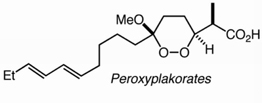Chemistry, Department of: Faculty Series

Patrick Dussault Publications
Document Type
Article
Date of this Version
September 2006
Abstract
This account describes the development of methodologies for ‘reductive’ ozonolysis, the direct ozonolytic conversion of alkenes into carbonyl groups without the intermediacy of 1,2,4-trioxolanes (ozonides). Ozonolysis of alkenes in the presence of DMSO produces a mixture of aldehyde and ozonide. The combination of DMSO and Et3N results in improved yields of carbonyls but still leaves unacceptable levels of residual ozonides; similar results are obtained using secondary or tertiary amines in the absence of DMSO. The influence of amines is believed to result from conversion to the corresponding N-oxides; ozonolysis in the presence of amine N-oxides efficiently suppresses ozonide formation, generating high yields of aldehydes. The reactions with amine oxides are hypothesized to involve an unprecedented trapping of carbonyl oxides to generate a zwitterionic adduct, which fragments to produce the desired carbonyl group, an amine, and 1O2.


Comments
Published in Tetrahedron 62 (2006), pp. 10747–10752. doi:10.1016/j.tet.2006.08.092 Copyright © 2006 Elsevier Ltd. Used by permission. http://www.sciencedirect.com/science/journal/00404020.